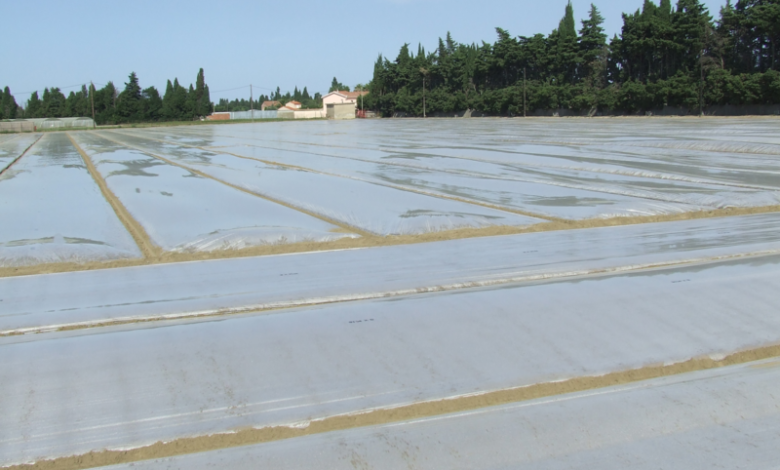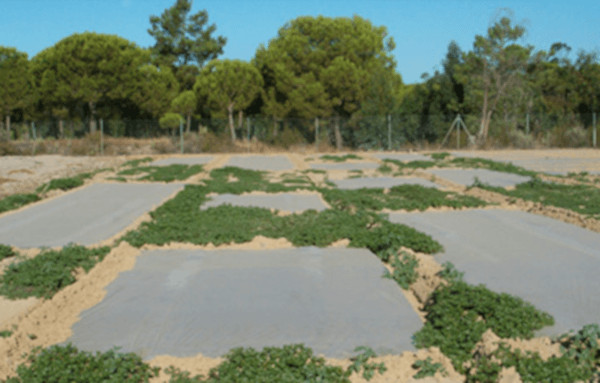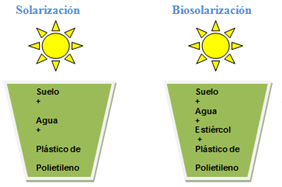Soil solarization. Ecological disinfection with plastic

After the last post about soil nematodes and the problems they cause in garden plants, I thought it was a good idea to talk about solarization, since this is one of the measures we can take to eliminate this pest of tiny worms.

In any case, as we will see in this post, soil solarization is an ecological technique that is used to solve other problems of horticultural plants, in addition to nematodes. In this post I will tell you what the objectives of soil solarization are and what this ecological disinfection technique consists of.
What is solarization?
Solarization is a technique of soil disinfection by heat. The heat is achieved thanks to the greenhouse effect that is produced by the incidence of the sun’s radiation on a plastic sheet that is placed on the ground.
Ecological disinfection of soils by solarization. Steps to follow
It is recommended that this be done when it is hot, during the spring or summer, so that the temperatures reached under the plastic are high enough to disinfect the soil and kill all the pathogens and weeds that are in it.
The plastic can be transparent or black, although there are experts who recommend black since this color absorbs more heat, so higher temperatures can be reached inside.
Before placing the plastic, the soil must be weeded, removing all the remains of plants and weeds.
Water the soil abundantly so that the water accumulates heat and acts as a conductive element.
Place the plastic on the ground with fixings to the ground in the corners, and on the sides with ridges of earth, gravel or something that prevents it from being lifted by the wind and increases ventilation in the ground surface area.
What is solarization used for? Objectives
As I have already mentioned, both solarization and biosolarization are techniques used for soil disinfection.
They are beginning to be widely used in Organic Agriculture because they can replace methyl bromide, a chemical substance used in conventional agriculture to eradicate fungi, nematodes and weeds from the soil.
In addition to fungi, weeds, and nematodes, these techniques are useful for removing viruses (such as Tomato Mosaic Virus) from the soil. We already saw in the post « Viruses in garden plants. What are they and what to do » that these microorganisms are the cause of serious problems, since diseased plants cannot be cured and must be eliminated. In addition, like nematodes, they are difficult to eradicate and can remain dormant for long periods in the soil, affecting our garden plants for years.
Biosolarization: A variant of soil solarization
For all this, solarization and biosolarization are two highly recommended techniques for the definitive elimination of viruses and nematodes from the soil.
These techniques are also effective in removing from the soil the remains of many pesticides and artificial substances (chemical fertilizers, for example) that have been previously applied to the soil.
So if you are in the process of converting from conventional agriculture to organic farming, this will be a good method to get rid of part of the residues left in the soil by chemical treatments. Although studies are still being carried out on this, and it is not known for sure how many biosolarization treatments are needed to completely eliminate residues from the soil, what is clear is that they do help to greatly reduce these residues, which are so persistent..
Biosolarization also produces a significant improvement in the physical, chemical and biological characteristics of the soil. It is an effective method against » soil exhaustion « (that is, when the soil is «exhausted» after many years of production).
A variant of solarization is biosolarization. It is more or less the same philosophy (getting heat under a plastic), only in this case another component comes into play: manure.

Manure and, in general, organic remains, when decomposed, emit gases (organic acids, ammonium, nitrates, hydrogen sulfide, etc.) that are toxic to insects and microorganisms. This fact, together with the high temperatures that are reached (which are higher than if it is only solarization) make soil disinfection even more effective.
How to install a biosolarization system?
So that you can see the opinion of some experts on the subject and farmers who are already using this method, I leave you this video in which you can see how a biosolarization system is installed in a big way.
If you want to do it in your garden, you will not need a tractor or a machine to spread the plastic, with a shovel for the manure and a couple of people will be more than enough. To make it as airtight as possible, as you can see in the video (minute 0:44), you can pour dirt on the ends of the plastic, even place stones or some heavy material to make sure it won’t blow away with the wind.
As you can see, these techniques have a lot of advantages and are not difficult to carry out. In addition, they are 100% ecological methods that will help you solve a lot of problems without having to use chemicals or artificial products. If you want more information on the subject, you can find out more about biosolarization in this scientific article.
References
- Asma, M., Al-Assas, K., Dawabah, A. (2016).Prevalence, distribution and intraspecific variation of Heterodera schachtii populations from semiarid environment. Saudi Journal of Biological Sciences, 23(2), 293-299.
- Buena, A., Díez-Rojo, M., López-Pérez, J., Robertson, L., Escuer, M., Bello, A. (2008). Screening of Tagetes patula L. on different populations of Meloidogyne. Crop Protection, 27(1), 96-100.
- M. López-Gómez, E. Flor-Peregrín, M. Talavera, FJ Sorribas, S. Verdejo-Lucas. (2015). Population dynamics of Meloidogyne javanica and its relationship with the leaf chlorophyll content in zucchini, Crop Protection, 70, 8-14.
I hope you found it as interesting a topic as I did. All the best.

![Photo of The Gerbera: [Care, Planting, Irrigation, Light and Substrate]](https://www.complete-gardening.com/wp-content/uploads/2022/08/the-gerbera-care-planting-irrigation-light-and-substrate-390x220.jpg)
![Photo of The Berberis: [Care, Planting, Irrigation, Substrate and Pests]](https://www.complete-gardening.com/wp-content/uploads/2022/08/the-berberis-care-planting-irrigation-substrate-and-pests-390x220.jpg)
![Photo of Yew: [Characteristics, Cultivation, Care and Disadvantages]](https://www.complete-gardening.com/wp-content/uploads/2022/08/yew-characteristics-cultivation-care-and-disadvantages-390x220.jpg)
![Photo of Dichondra: [Characteristics, Care, Planting and Reproduction]](https://www.complete-gardening.com/wp-content/uploads/2022/08/dichondra-characteristics-care-planting-and-reproduction-390x220.jpg)